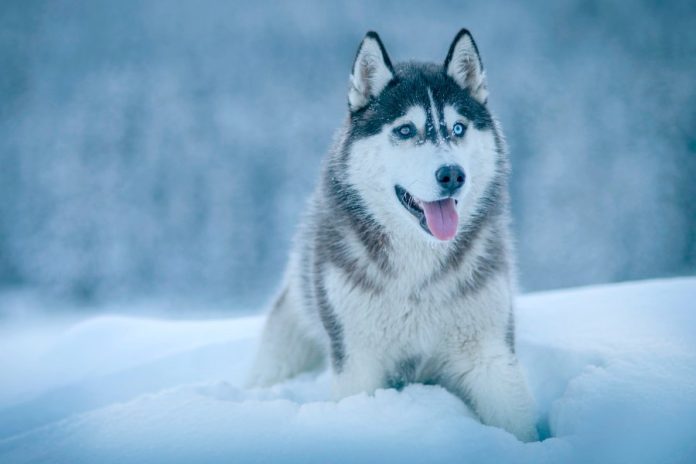Husky dogs are renowned for their striking appearance and thick double coat, which serves as a natural defence against harsh weather conditions. These hardy canines are well-suited to colder climates and can thrive in temperatures that might send shivers down our spines. In this blog post, we’ll explore the fascinating adaptations that make huskies well-equipped to handle chilly environments and why they excel in cold weather.
Can Husky Dogs Live In Cold Weather:
Double Coat Magic:
Huskies boast a distinctive double coat, consisting of a dense, insulating undercoat and a longer outer coat that repels water and snow. This unique combination provides them with effective protection against frigid temperatures, allowing them to maintain a comfortable body temperature even in the coldest of conditions.
Built-In Temperature Regulation:
Unlike some breeds that struggle in extreme temperatures, huskies are adept at regulating their body temperature. Their coats are designed not only to keep them warm in cold weather but also to help them stay cool in warmer conditions. This adaptability makes huskies well-suited for a range of environments, though they truly shine in colder climates.
Active Lifestyle:
Huskies are known for their boundless energy and love for physical activity. This active lifestyle generates internal heat, aiding in keeping them warm. Regular exercise is not just enjoyable for these dogs but also essential for their overall well-being, helping them stay fit and maintain a healthy body temperature even when the mercury drops.
Cold-Weather Heritage:
Originating from Siberia, where temperatures can plummet to extreme lows, huskies have a genetic predisposition for cold weather. Over generations, their ancestors developed the traits needed to survive in the harshest of Arctic conditions. This heritage is a testament to their resilience in the face of cold climates.
Behavioural Adaptations:
- Huskies are known to exhibit certain behaviours that aid in their survival in cold weather. They are prone to digging, creating shelters, and curling up to conserve body heat. These instinctual behaviours, passed down through generations, further enhance their ability to thrive in chilly environments.
Impact On Husky Dogs In Summer:
Huskies, with their thick double coats and Arctic heritage, are well-adapted to cold weather. However, the heat of summer can pose challenges for them. Here are details about the impact of summer on husky dogs:
Heat Sensitivity:
- Overheating Risk: Huskies are prone to overheating in hot weather due to their dense double coat, which can trap heat. Their original Siberian environment had colder temperatures, so they may struggle to regulate their body temperature in warmer climates.
Cooling Strategies:
- Shedding: Huskies undergo a process called “blowing coat” during warmer months. They shed their undercoat to some extent, which helps them adapt to higher temperatures.
- Digging and Resting: Huskies may dig holes to create proper cool spots and may prefer resting on cooler surfaces like tile floors. Providing them with shaded areas and access to cool water is essential.
Exercise Management:
- Early Morning or Late Evening Exercise: Due to their susceptibility to heat, it’s advisable to exercise huskies during the cooler parts of the day, such as early mornings or late evenings.
- Avoid Overexertion: Huskies, despite their energy, should not be pushed to overexertion in hot weather. High temperatures can lead to dehydration and heatstroke.
Hydration Importance:
- Water Accessibility: Ensuring huskies have constant access to fresh water is crucial. Dehydration can be a serious concern, especially in the heat.
- Ice Treats: Some husky owners provide ice treats or frozen toys to help keep their dogs cool.
Sun Protection:
- Sunburn Risk: Huskies have also pigmented skin, but areas with less fur, such as the nose, may be susceptible to sunburn. Applying pet-safe sunscreen to these areas is advisable.
- Providing Shade: Creating shaded areas in the backyard or during outdoor activities is important to protect them from direct sunlight.
Avoiding Hot Surfaces:
- Sensitive Paw Pads: Huskies can be sensitive to hot surfaces, such as asphalt. Walking them during cooler times of the day or on grassy surfaces can prevent discomfort and potential paw pad injuries.
Grooming Considerations:
- Regular Brushing: Despite shedding their undercoat, regular brushing during the summer helps remove loose fur and improves air circulation, aiding in temperature regulation.
- Avoid Shaving: While it might seem logical to shave a husky in hot weather, their coat actually provides insulation against both cold and hot temperatures. Shaving can interfere with their natural cooling mechanisms.
Monitoring for Signs of Overheating:
- Excessive Panting: Rapid or excessive panting is a sign that a husky may be overheating.
- Lethargy and Weakness: If a husky appears lethargic, weak, or disoriented, immediate steps should be taken to cool them down, and veterinary attention may be needed.
Understanding and addressing the impact of summer on husky dogs is crucial for their well-being. Responsible ownership involves providing the necessary resources and adjustments to help them stay cool and comfortable during warmer months.
Providing proper training, socialisation, and also meeting their exercise needs are key to having a happy and well-adjusted husky companion.
Conclusion
In conclusion, husky dogs are well-equipped to not only endure but flourish in cold weather. Their unique double coat, innate temperature regulation abilities, active lifestyle, cold-weather heritage, and behavioural adaptations make them a perfect fit for regions with colder climates. If you’re considering bringing a husky into your family, providing them with the right care, attention, and opportunities for exercise will ensure they lead a happy and healthy life in the cold embrace of winter.


